INFINITI QX60 2023 Owners Manual
Manufacturer: INFINITI, Model Year: 2023, Model line: QX60, Model: INFINITI QX60 2023Pages: 636, PDF Size: 7.28 MB
Page 601 of 636
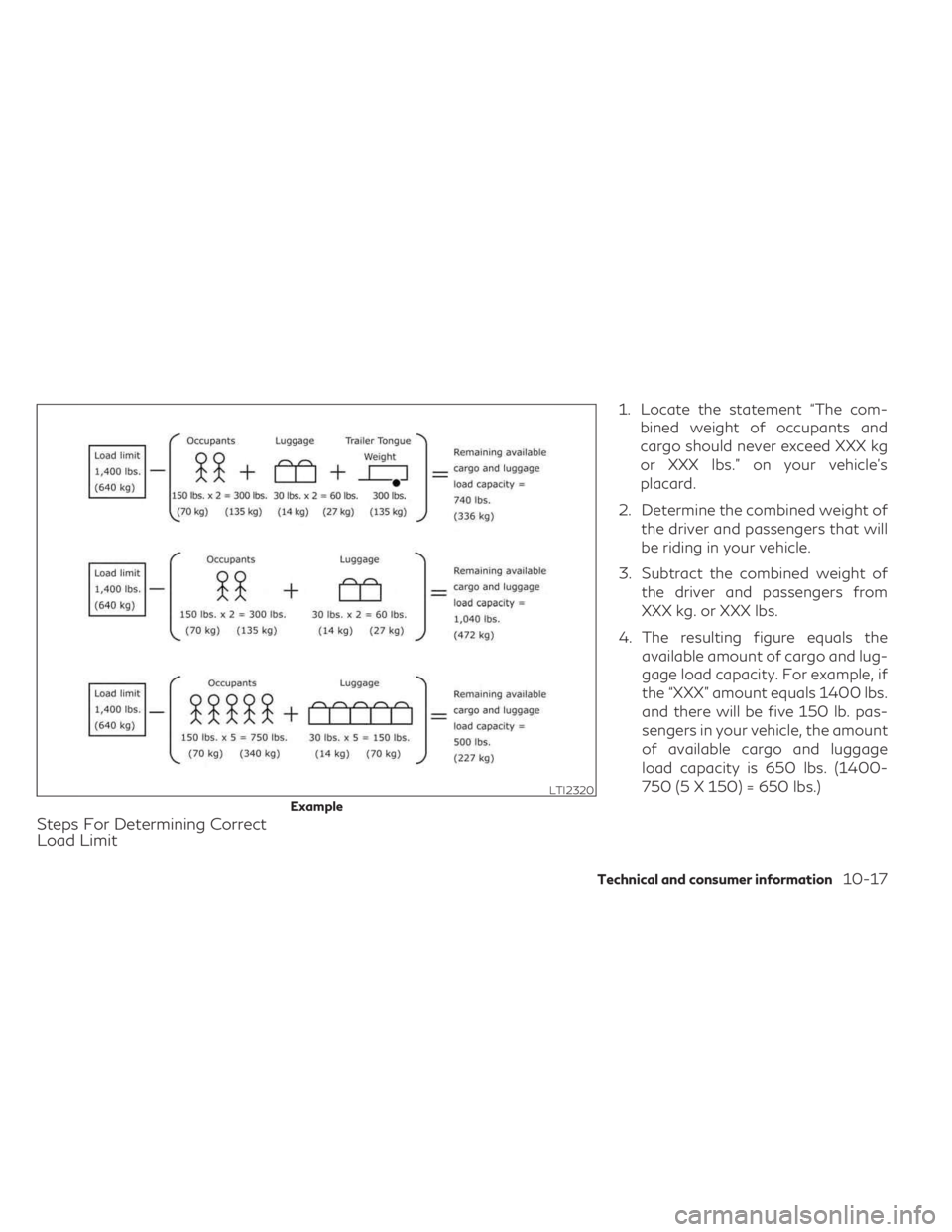
Steps For Determining Correct
Load Limit
1. Locate the statement “The com-bined weight of occupants and
cargo should never exceed XXX kg
or XXX lbs.” on your vehicle’s
placard.
2. Determine the combined weight of the driver and passengers that will
be riding in your vehicle.
3. Subtract the combined weight of the driver and passengers from
XXX kg. or XXX lbs.
4. The resulting figure equals the available amount of cargo and lug-
gage load capacity. For example, if
the “XXX” amount equals 1400 lbs.
and there will be five 150 lb. pas-
sengers in your vehicle, the amount
of available cargo and luggage
load capacity is 650 lbs. (1400-
750 (5 X 150) = 650 lbs.)
LTI2320
Example
Technical and consumer information10-17
Page 602 of 636
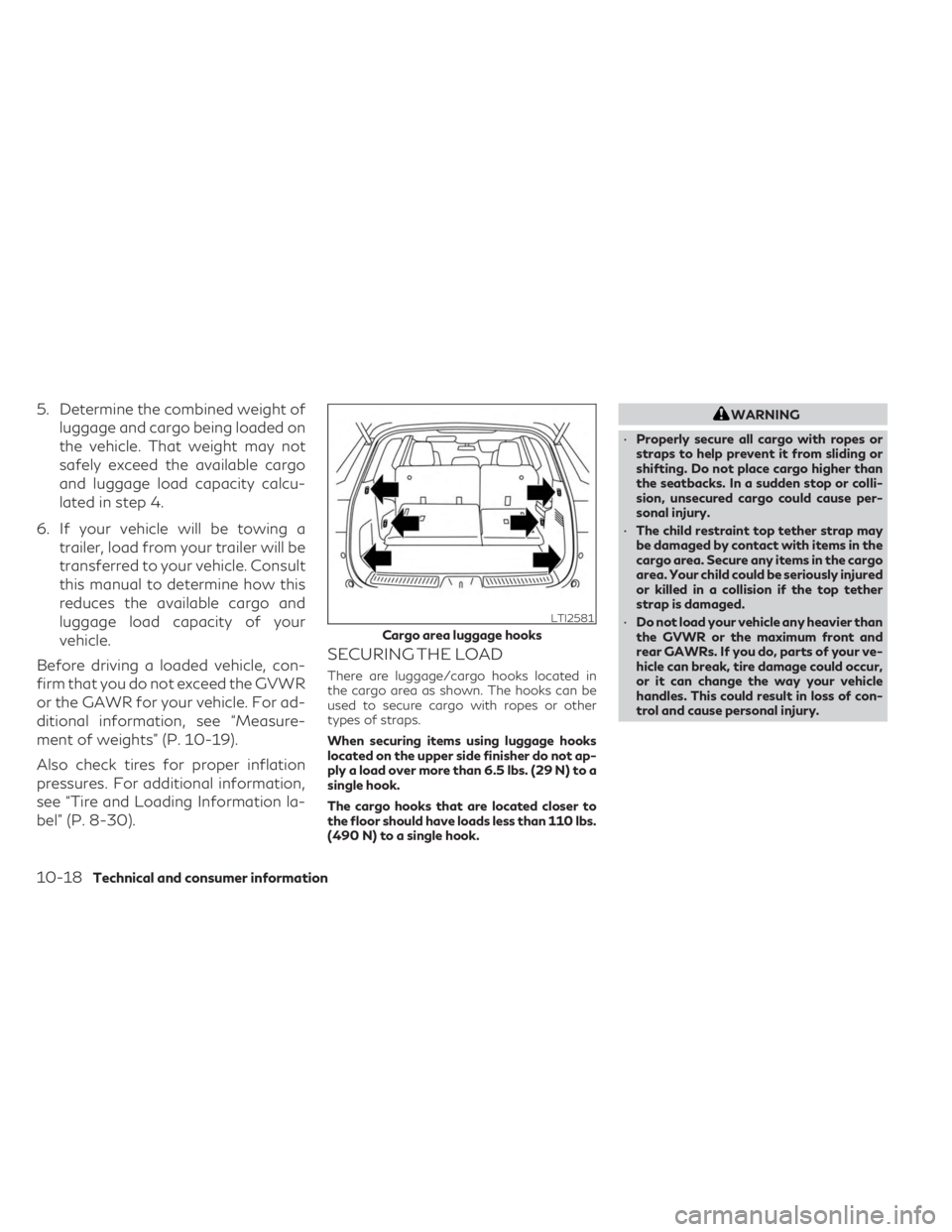
5. Determine the combined weight ofluggage and cargo being loaded on
the vehicle. That weight may not
safely exceed the available cargo
and luggage load capacity calcu-
lated in step 4.
6. If your vehicle will be towing a trailer, load from your trailer will be
transferred to your vehicle. Consult
this manual to determine how this
reduces the available cargo and
luggage load capacity of your
vehicle.
Before driving a loaded vehicle, con-
firm that you do not exceed the GVWR
or the GAWR for your vehicle. For ad-
ditional information, see “Measure-
ment of weights” (P. 10-19).
Also check tires for proper inflation
pressures. For additional information,
see “Tire and Loading Information la-
bel” (P. 8-30).
SECURING THE LOAD
There are luggage/cargo hooks located in
the cargo area as shown. The hooks can be
used to secure cargo with ropes or other
types of straps.
When securing items using luggage hooks
located on the upper side finisher do not ap-
ply a load over more than 6.5 lbs. (29 N) to a
single hook.
The cargo hooks that are located closer to
the floor should have loads less than 110 lbs.
(490 N) to a single hook.
WARNING
• Properly secure all cargo with ropes or
straps to help prevent it from sliding or
shifting. Do not place cargo higher than
the seatbacks. In a sudden stop or colli-
sion, unsecured cargo could cause per-
sonal injury.
• The child restraint top tether strap may
be damaged by contact with items in the
cargo area. Secure any items in the cargo
area. Your child could be seriously injured
or killed in a collision if the top tether
strap is damaged.
• Do not load your vehicle any heavier than
the GVWR or the maximum front and
rear GAWRs. If you do, parts of your ve-
hicle can break, tire damage could occur,
or it can change the way your vehicle
handles. This could result in loss of con-
trol and cause personal injury.
LTI2581
Cargo area luggage hooks
10-18Technical and consumer information
Page 603 of 636
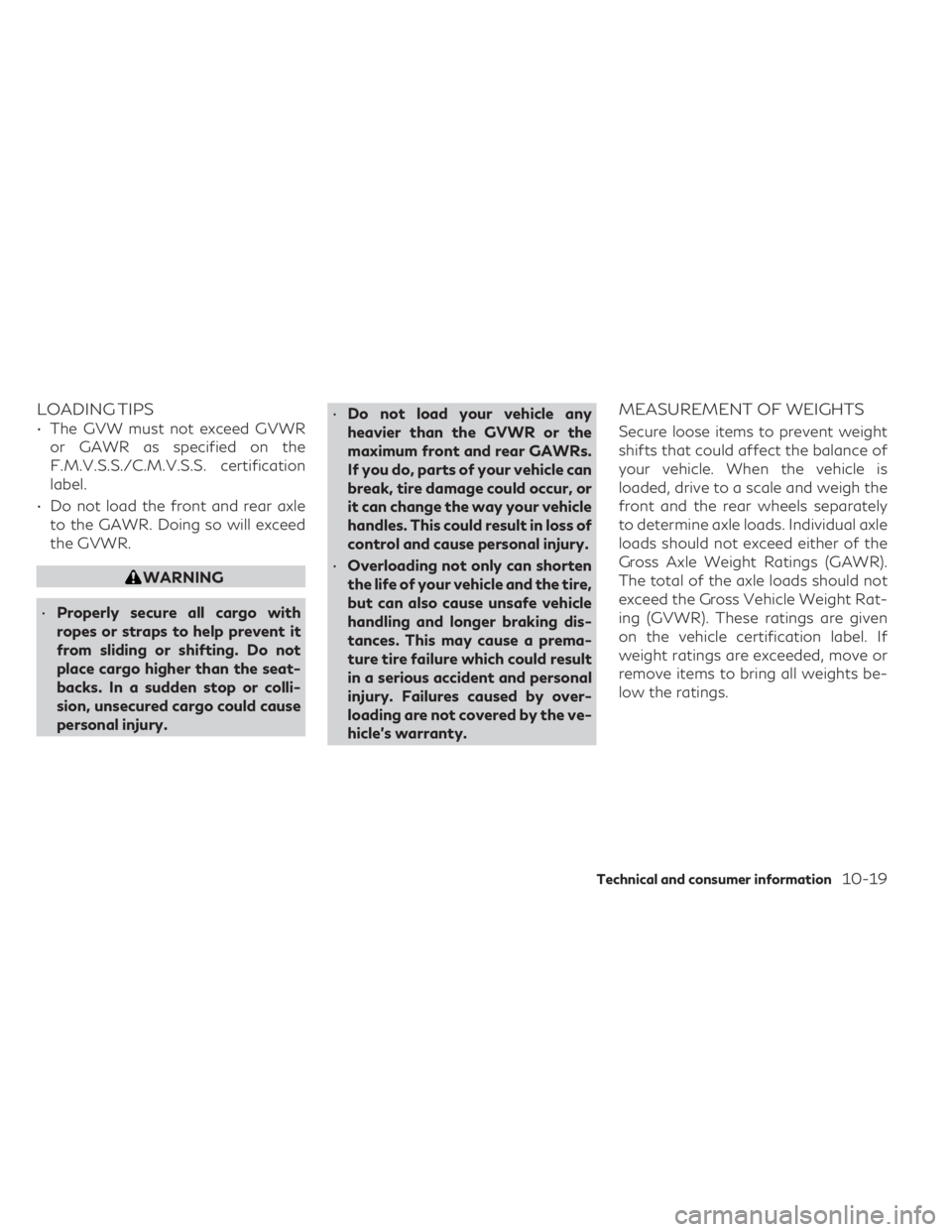
LOADING TIPS
• The GVW must not exceed GVWRor GAWR as specified on the
F.M.V.S.S./C.M.V.S.S. certification
label.
• Do not load the front and rear axle to the GAWR. Doing so will exceed
the GVWR.
WARNING
• Properly secure all cargo with
ropes or straps to help prevent it
from sliding or shifting. Do not
place cargo higher than the seat-
backs. In a sudden stop or colli-
sion, unsecured cargo could cause
personal injury. •
Do not load your vehicle any
heavier than the GVWR or the
maximum front and rear GAWRs.
If you do, parts of your vehicle can
break, tire damage could occur, or
it can change the way your vehicle
handles. This could result in loss of
control and cause personal injury.
• Overloading not only can shorten
the life of your vehicle and the tire,
but can also cause unsafe vehicle
handling and longer braking dis-
tances. This may cause a prema-
ture tire failure which could result
in a serious accident and personal
injury. Failures caused by over-
loading are not covered by the ve-
hicle’s warranty.
MEASUREMENT OF WEIGHTS
Secure loose items to prevent weight
shifts that could affect the balance of
your vehicle. When the vehicle is
loaded, drive to a scale and weigh the
front and the rear wheels separately
to determine axle loads. Individual axle
loads should not exceed either of the
Gross Axle Weight Ratings (GAWR).
The total of the axle loads should not
exceed the Gross Vehicle Weight Rat-
ing (GVWR). These ratings are given
on the vehicle certification label. If
weight ratings are exceeded, move or
remove items to bring all weights be-
low the ratings.
Technical and consumer information10-19
Page 604 of 636

WARNING
Overloading or improper loading of a
trailer and its cargo can adversely affect
vehicle handling, braking and performance
and may lead to accidents.
CAUTION
• Do not tow a trailer or haul a heavy load
for the first 500 miles (805 km). Your
engine, axle or other parts could be
damaged.
• For the first 500 miles (805 km) that you
tow a trailer, do not drive over 50 mph
(80 km/h) and do not make starts at full
throttle. This helps the engine and other
parts of your vehicle wear in at the
heavier loads.
NOTE:
Tow hitches are available as an accessory for
this vehicle. Please visit an INFINITI retailer
for additional equipment required for this
accessory.
Your new vehicle was designed to be used
primarily to carry passengers and cargo. Re-
member that towing a trailer places addi-
tional loads on your vehicle's engine, drive
train, steering, braking and other systems.
An INFINITI Towing Guide (U.S. only) is avail-
able on the website at www.InfinitiUSA.com.
This guide includes information on trailer
towing capability and the special equipment
required for proper towing.
MAXIMUM LOAD LIMITS
Maximum trailer loads
Never allow the total trailer load to exceed
the value specified in the following Towing
Load/Specification Chart found in this sec-
tion. The total trailer load equals trailer
weight plus its cargo weight.
• When towing a trailer load of 3,500 lbs.
(1,587 kg) or more, trailers with a brake
system MUST be used.
The maximum Gross Combined Weight Rat-
ing (GCWR) should not exceed the value
specified in the following Towing Load/
Specification Chart. The GCWR equals the combined weight of
the towing vehicle (including passengers and
cargo) plus the total trailer load. Towing
loads greater than these or using improper
towing equipment could adversely affect ve-
hicle handling, braking and performance.
The ability of your vehicle to tow a trailer is
not only related to the maximum trailer loads,
but also the places you plan to tow. Tow
weights appropriate for level highway driving
may have to be reduced for low traction situ-
ations (for example, on slippery boat ramps).
LTI2582
TOWING A TRAILER
10-20Technical and consumer information
Page 605 of 636

Temperature conditions can also affect tow-
ing. For example, towing a heavy trailer in
high outside temperatures on graded roads
can affect engine performance and cause
overheating. Vehicle speed may decrease un-
der high load. Plan your trip carefully to ac-
count for trailer and vehicle load, weather
and road conditions.
WARNING
Overheating can result in reduced engine
power and vehicle speed. The reduced
speed may be lower than other traffic,
which could increase the chance of a colli-
sion. Be especially careful when driving.
If the vehicle cannot maintain a safe driving
speed, pull to the side of the road in a safe
area. Allow the engine to cool and return
to normal operation. For additional infor-
mation, see “If your vehicle overheats”
(P. 6-14).
CAUTION
Vehicle damage resulting from improper
towing procedures is not covered by
INFINITI warranties.
Tongue load
When using a weight carrying or a weight
distributing hitch, keep the tongue load be-
tween 10 - 15% of the total trailer load or use
the trailer tongue load specified by the trailer
manufacturer. The tongue load must be
within the maximum tongue load limits
shown in the following “Towing Load/
Specification” chart. If the tongue load be-
comes excessive, rearrange cargo to allow
for proper tongue load.
Maximum Gross Vehicle Weight
(GVW)/maximum Gross Axle
Weight (GAW)
The GVW of the towing vehicle must not
exceed the Gross Vehicle Weight Rating
(GVWR) shown on the F.M.V.S.S./C.M.V.S.S.
certification label. The GVW equals the com-
bined weight of the unloaded vehicle, pas-
sengers, luggage, hitch, trailer tongue load
and any other optional equipment. In addi-
tion, front or rear GAW must not exceed the
Gross Axle Weight Rating (GAWR) shown on
the F.M.V.S.S./C.M.V.S.S. certification label.
WTI0160LTI2583
Technical and consumer information10-21
Page 606 of 636
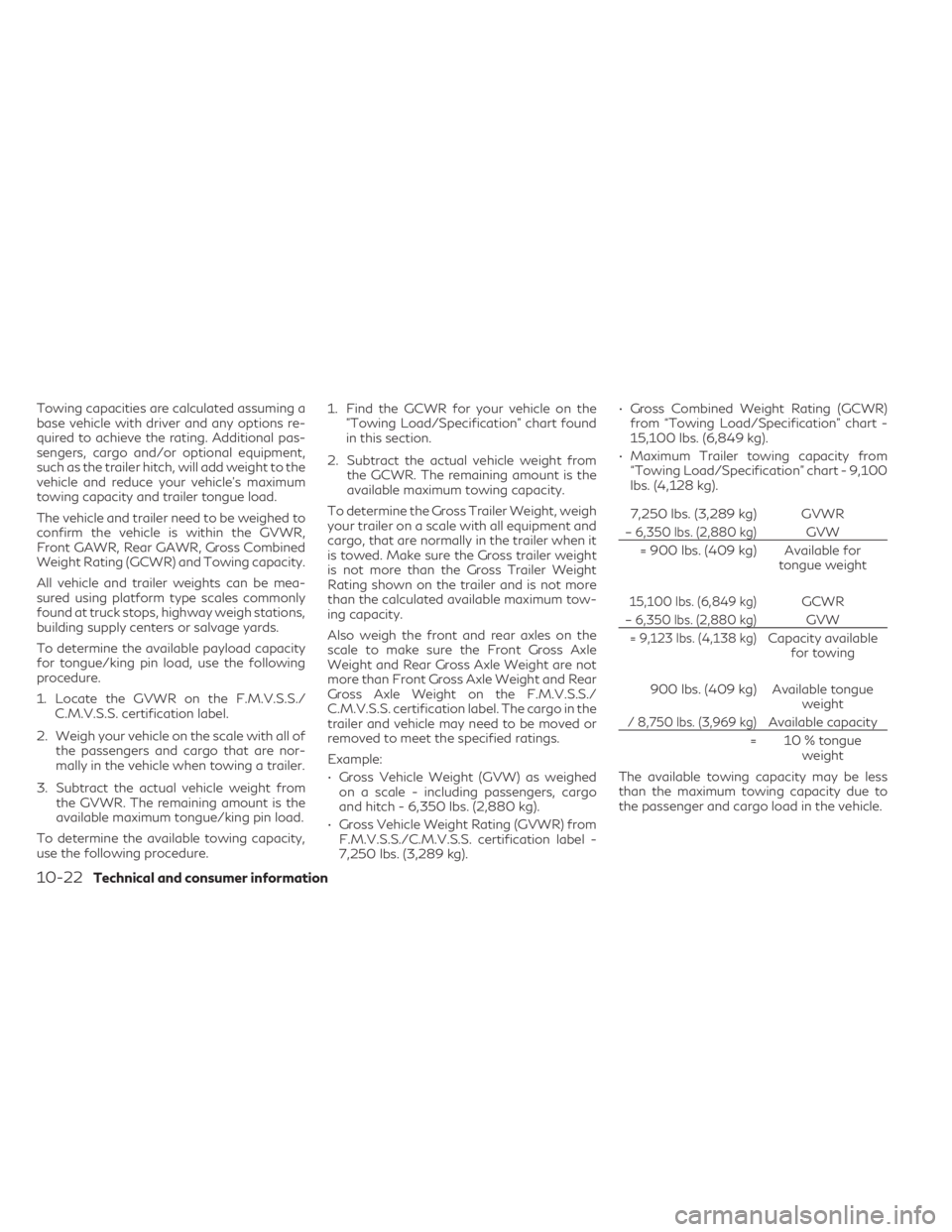
Towing capacities are calculated assuming a
base vehicle with driver and any options re-
quired to achieve the rating. Additional pas-
sengers, cargo and/or optional equipment,
such as the trailer hitch, will add weight to the
vehicle and reduce your vehicle’s maximum
towing capacity and trailer tongue load.
The vehicle and trailer need to be weighed to
confirm the vehicle is within the GVWR,
Front GAWR, Rear GAWR, Gross Combined
Weight Rating (GCWR) and Towing capacity.
All vehicle and trailer weights can be mea-
sured using platform type scales commonly
found at truck stops, highway weigh stations,
building supply centers or salvage yards.
To determine the available payload capacity
for tongue/king pin load, use the following
procedure.
1. Locate the GVWR on the F.M.V.S.S./C.M.V.S.S. certification label.
2. Weigh your vehicle on the scale with all of the passengers and cargo that are nor-
mally in the vehicle when towing a trailer.
3. Subtract the actual vehicle weight from the GVWR. The remaining amount is the
available maximum tongue/king pin load.
To determine the available towing capacity,
use the following procedure. 1. Find the GCWR for your vehicle on the
"Towing Load/Specification" chart found
in this section.
2. Subtract the actual vehicle weight from the GCWR. The remaining amount is the
available maximum towing capacity.
To determine the Gross Trailer Weight, weigh
your trailer on a scale with all equipment and
cargo, that are normally in the trailer when it
is towed. Make sure the Gross trailer weight
is not more than the Gross Trailer Weight
Rating shown on the trailer and is not more
than the calculated available maximum tow-
ing capacity.
Also weigh the front and rear axles on the
scale to make sure the Front Gross Axle
Weight and Rear Gross Axle Weight are not
more than Front Gross Axle Weight and Rear
Gross Axle Weight on the F.M.V.S.S./
C.M.V.S.S. certification label. The cargo in the
trailer and vehicle may need to be moved or
removed to meet the specified ratings.
Example:
• Gross Vehicle Weight (GVW) as weighed on a scale - including passengers, cargo
and hitch - 6,350 lbs. (2,880 kg).
• Gross Vehicle Weight Rating (GVWR) from F.M.V.S.S./C.M.V.S.S. certification label -
7,250 lbs. (3,289 kg). • Gross Combined Weight Rating (GCWR)
from “Towing Load/Specification" chart -
15,100 lbs. (6,849 kg).
• Maximum Trailer towing capacity from “Towing Load/Specification" chart - 9,100
lbs. (4,128 kg).
7,250 lbs. (3,289 kg) GVWR
– 6,350 lbs. (2,880 kg)GVW
= 900 lbs. (409 kg) Available for tongue weight
15,100 lbs. (6,849 kg)GCWR
– 6,350 lbs. (2,880 kg)GVW
= 9,123 lbs. (4,138 kg)Capacity availablefor towing
900 lbs. (409 kg) Available tongue weight
/ 8,750 lbs. (3,969 kg)Available capacity
= 10 % tongue weight
The available towing capacity may be less
than the maximum towing capacity due to
the passenger and cargo load in the vehicle.
10-22Technical and consumer information
Page 607 of 636
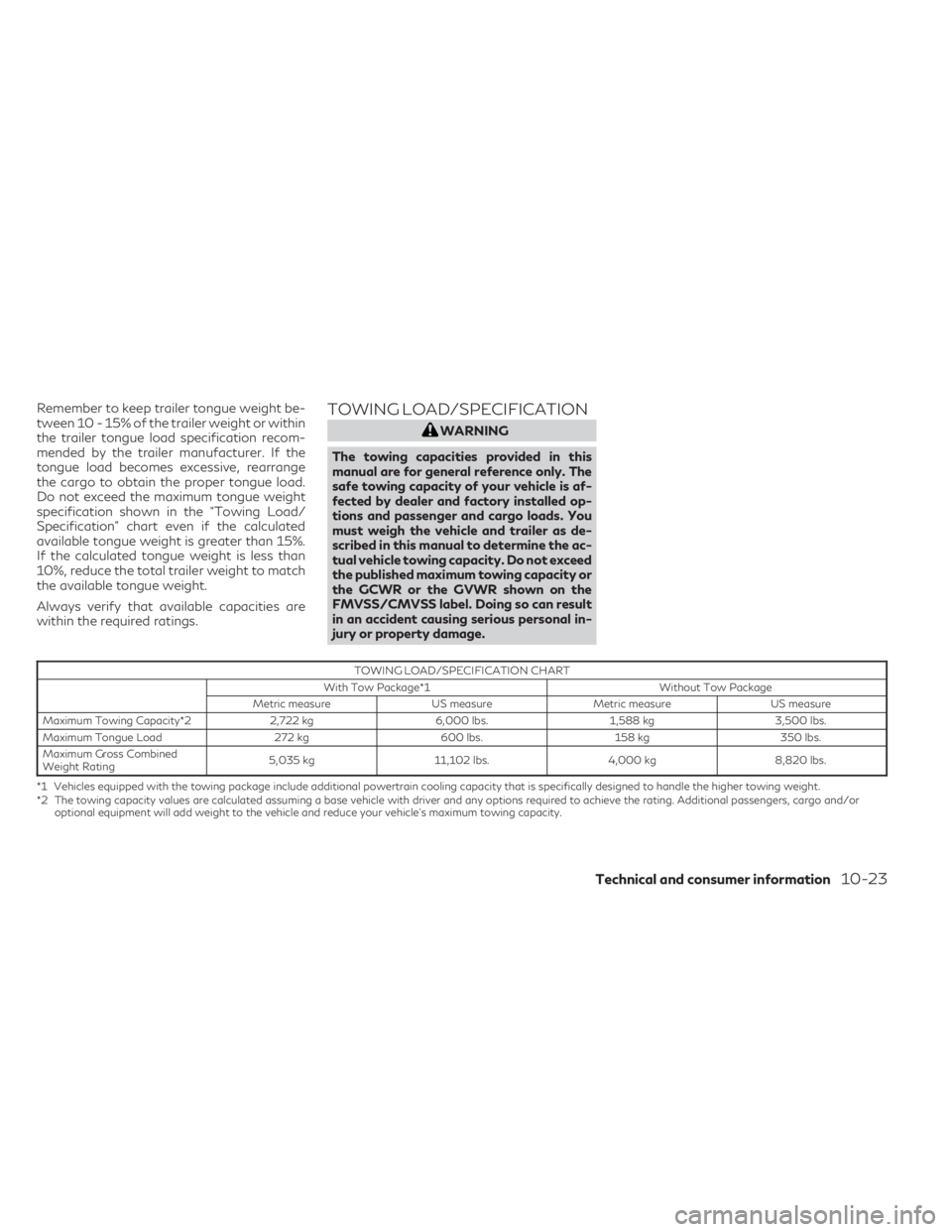
Remember to keep trailer tongue weight be-
tween 10 - 15% of the trailer weight or within
the trailer tongue load specification recom-
mended by the trailer manufacturer. If the
tongue load becomes excessive, rearrange
the cargo to obtain the proper tongue load.
Do not exceed the maximum tongue weight
specification shown in the “Towing Load/
Specification” chart even if the calculated
available tongue weight is greater than 15%.
If the calculated tongue weight is less than
10%, reduce the total trailer weight to match
the available tongue weight.
Always verify that available capacities are
within the required ratings.TOWING LOAD/SPECIFICATION
WARNING
The towing capacities provided in this
manual are for general reference only. The
safe towing capacity of your vehicle is af-
fected by dealer and factory installed op-
tions and passenger and cargo loads. You
must weigh the vehicle and trailer as de-
scribed in this manual to determine the ac-
tual vehicle towing capacity. Do not exceed
the published maximum towing capacity or
the GCWR or the GVWR shown on the
FMVSS/CMVSS label. Doing so can result
in an accident causing serious personal in-
jury or property damage.
TOWING LOAD/SPECIFICATION CHART
With Tow Package*1 Without Tow Package
Metric measure US measureMetric measure US measure
Maximum Towing Capacity*2 2,722 kg6,000 lbs. 1,588 kg3,500 lbs.
Maximum Tongue Load 272 kg600 lbs. 158 kg350 lbs.
Maximum Gross Combined
Weight Rating 5,035 kg
11,102 lbs. 4,000 kg8,820 lbs.
*1 Vehicles equipped with the towing package include additional powertrain cooling capacity that is specifically designed to handle the higher towing weight.
*2 The towing capacity values are calculated assuming a base vehicle with driver and any options required to achieve the rating. Additional passengers, cargo and/or optional equipment will add weight to the vehicle and reduce your vehicle's maximum towing capacity.
Technical and consumer information10-23
Page 608 of 636
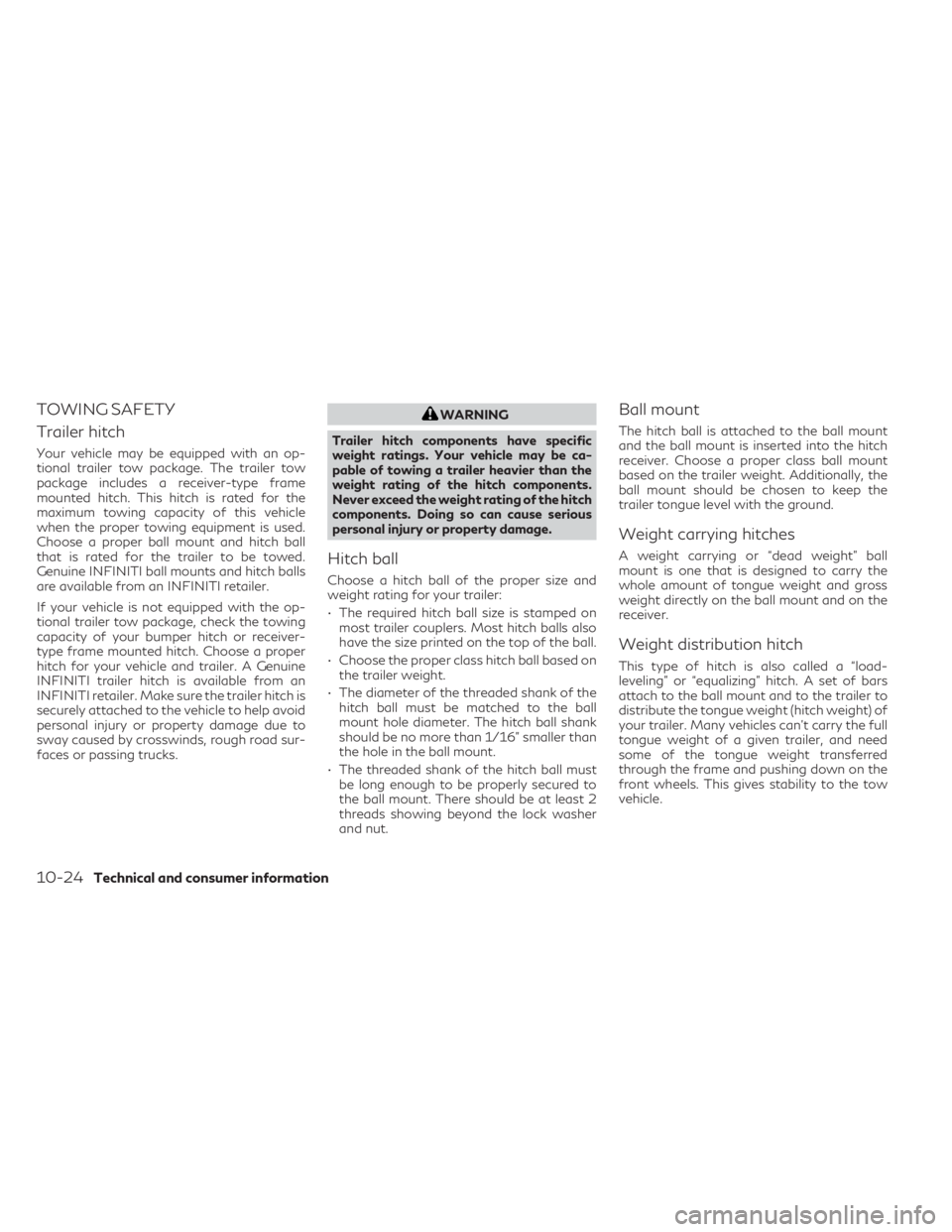
TOWING SAFETY
Trailer hitch
Your vehicle may be equipped with an op-
tional trailer tow package. The trailer tow
package includes a receiver-type frame
mounted hitch. This hitch is rated for the
maximum towing capacity of this vehicle
when the proper towing equipment is used.
Choose a proper ball mount and hitch ball
that is rated for the trailer to be towed.
Genuine INFINITI ball mounts and hitch balls
are available from an INFINITI retailer.
If your vehicle is not equipped with the op-
tional trailer tow package, check the towing
capacity of your bumper hitch or receiver-
type frame mounted hitch. Choose a proper
hitch for your vehicle and trailer. A Genuine
INFINITI trailer hitch is available from an
INFINITI retailer. Make sure the trailer hitch is
securely attached to the vehicle to help avoid
personal injury or property damage due to
sway caused by crosswinds, rough road sur-
faces or passing trucks.
WARNING
Trailer hitch components have specific
weight ratings. Your vehicle may be ca-
pable of towing a trailer heavier than the
weight rating of the hitch components.
Never exceed the weight rating of the hitch
components. Doing so can cause serious
personal injury or property damage.
Hitch ball
Choose a hitch ball of the proper size and
weight rating for your trailer:
• The required hitch ball size is stamped on most trailer couplers. Most hitch balls also
have the size printed on the top of the ball.
• Choose the proper class hitch ball based on the trailer weight.
• The diameter of the threaded shank of the hitch ball must be matched to the ball
mount hole diameter. The hitch ball shank
should be no more than 1/16” smaller than
the hole in the ball mount.
• The threaded shank of the hitch ball must be long enough to be properly secured to
the ball mount. There should be at least 2
threads showing beyond the lock washer
and nut.
Ball mount
The hitch ball is attached to the ball mount
and the ball mount is inserted into the hitch
receiver. Choose a proper class ball mount
based on the trailer weight. Additionally, the
ball mount should be chosen to keep the
trailer tongue level with the ground.
Weight carrying hitches
A weight carrying or “dead weight” ball
mount is one that is designed to carry the
whole amount of tongue weight and gross
weight directly on the ball mount and on the
receiver.
Weight distribution hitch
This type of hitch is also called a “load-
leveling” or “equalizing” hitch. A set of bars
attach to the ball mount and to the trailer to
distribute the tongue weight (hitch weight) of
your trailer. Many vehicles can't carry the full
tongue weight of a given trailer, and need
some of the tongue weight transferred
through the frame and pushing down on the
front wheels. This gives stability to the tow
vehicle.
10-24Technical and consumer information
Page 609 of 636

A weight-distributing hitch system (Class IV)
is recommended if you plan to tow trailers
with a maximum weight over 5,000 lbs.
(2,268 kg). Check with the trailer and towing
equipment manufacturers to determine if
they recommend the use of a weight-
distributing hitch system.
NOTE:
A weight-distributing hitch system may af-
fect the operation of trailer surge brakes. If
you are considering use of a weight-
distributing hitch system with a surge
brake-equipped trailer, check with the surge
brake, hitch or trailer manufacturer to de-
termine if and how this can be done.
Follow the instructions provided by the
manufacturer for installing and using the
weight-distributing hitch system.
General set-up instructions are as follows:
1. Park unloaded vehicle on a level surface.With the ignition switch in the ON position
and the doors closed, allow the vehicle to
stand for several minutes so that it can
level.
2. Measure the height of a reference point on the front and rear bumpers at the cen-
ter of the vehicle. 3. Attach the trailer to the vehicle and adjust
the hitch equalizers so that the front bum-
per height is within0-.5inches (0 – 13
mm) of the reference height measured in
step 2. The rear bumper should be no
higher than the reference height mea-
sured in step 2.
WARNING
Properly adjust the weight distributing
hitch so the rear of the bumper is no higher
than the measured reference height when
the trailer is attached. If the rear bumper is
higher than the measured reference height
when loaded, the vehicle may handle un-
predictably which could cause a loss of ve-
hicle control and cause serious personal in-
jury or property damage.
Sway control device
Sudden maneuvers, wind gusts, and buffet-
ing caused by other vehicles can affect trailer
handling. Sway control devices may be used
to help control these affects. If you choose to
use one, contact a reputable trailer hitch sup-
plier to make sure the sway control device will
work with the vehicle, hitch, trailer and the
trailer's brake system. Follow the instructions
provided by the manufacturer for installing
and using the sway control device.
Class I hitch
Class I trailer hitch equipment (receiver, ball
mount and hitch ball) can be used to tow
trailers of a maximum weight of 2,000 lbs.
(907 kg).
Class II hitch
Class II trailer hitch equipment (receiver, ball
mount and hitch ball) can be used to tow
trailers of a maximum weight of 3,500 lbs.
(1,587 kg).
Class III hitch
Class III trailer hitch equipment (receiver, ball
mount and hitch ball) can be used to tow
trailers of a maximum weight of 5,000 lbs.
(2,268 kg).
Tire pressures
• When towing a trailer, inflate the vehicle tires to the recommended
cold tire pressure indicated on the
Tire and Loading Information label.
• Trailer tire condition, size, load rating and proper inflation pressure should
be in accordance with the trailer and
tire manufacturer's specifications.
Technical and consumer information10-25
Page 610 of 636
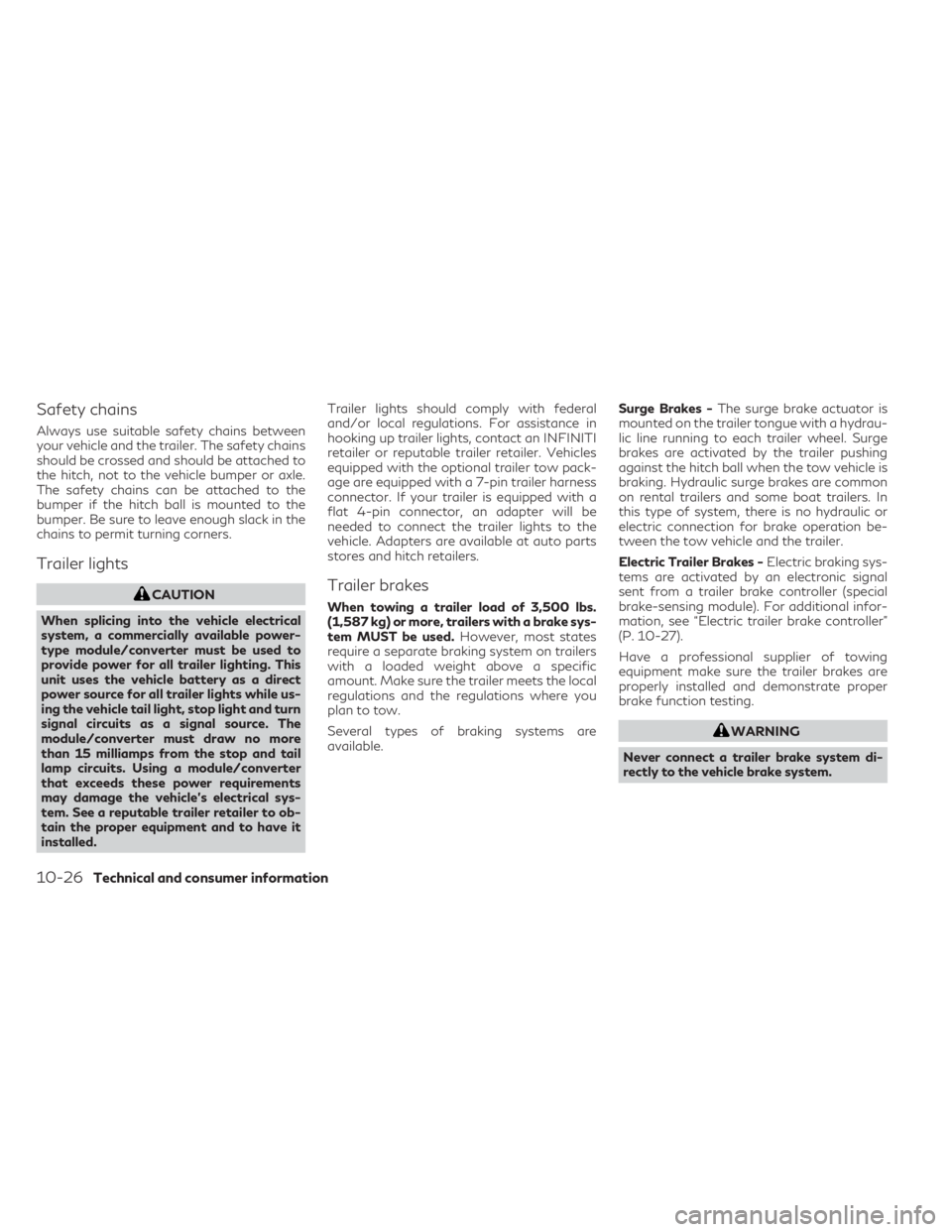
Safety chains
Always use suitable safety chains between
your vehicle and the trailer. The safety chains
should be crossed and should be attached to
the hitch, not to the vehicle bumper or axle.
The safety chains can be attached to the
bumper if the hitch ball is mounted to the
bumper. Be sure to leave enough slack in the
chains to permit turning corners.
Trailer lights
CAUTION
When splicing into the vehicle electrical
system, a commercially available power-
type module/converter must be used to
provide power for all trailer lighting. This
unit uses the vehicle battery as a direct
power source for all trailer lights while us-
ing the vehicle tail light, stop light and turn
signal circuits as a signal source. The
module/converter must draw no more
than 15 milliamps from the stop and tail
lamp circuits. Using a module/converter
that exceeds these power requirements
may damage the vehicle's electrical sys-
tem. See a reputable trailer retailer to ob-
tain the proper equipment and to have it
installed. Trailer lights should comply with federal
and/or local regulations. For assistance in
hooking up trailer lights, contact an INFINITI
retailer or reputable trailer retailer. Vehicles
equipped with the optional trailer tow pack-
age are equipped with a 7-pin trailer harness
connector. If your trailer is equipped with a
flat 4-pin connector, an adapter will be
needed to connect the trailer lights to the
vehicle. Adapters are available at auto parts
stores and hitch retailers.Trailer brakes
When towing a trailer load of 3,500 lbs.
(1,587 kg) or more, trailers with a brake sys-
tem MUST be used.
However, most states
require a separate braking system on trailers
with a loaded weight above a specific
amount. Make sure the trailer meets the local
regulations and the regulations where you
plan to tow.
Several types of braking systems are
available. Surge Brakes -
The surge brake actuator is
mounted on the trailer tongue with a hydrau-
lic line running to each trailer wheel. Surge
brakes are activated by the trailer pushing
against the hitch ball when the tow vehicle is
braking. Hydraulic surge brakes are common
on rental trailers and some boat trailers. In
this type of system, there is no hydraulic or
electric connection for brake operation be-
tween the tow vehicle and the trailer.
Electric Trailer Brakes - Electric braking sys-
tems are activated by an electronic signal
sent from a trailer brake controller (special
brake-sensing module). For additional infor-
mation, see “Electric trailer brake controller”
(P. 10-27).
Have a professional supplier of towing
equipment make sure the trailer brakes are
properly installed and demonstrate proper
brake function testing.
WARNING
Never connect a trailer brake system di-
rectly to the vehicle brake system.
10-26Technical and consumer information